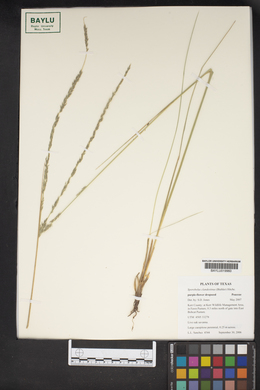Sporobolus clandestinus
|
|
|
|
Family: Poaceae
Rough Dropseed, more...Hidden Dropseed
[Agrostis clandestina Biehler, moreMuhlenbergia clandestina (Biehler) Trin., Sporobolus asper var. clandestinus (Biehler) Shinners, Vilfa clandestina (Biehler) Nees ex Steud.] |
Plants perennial; cespitose, occasionally rhizomatous. Culms 40-130(150) cm tall, 1-4 mm thick, frequently glaucous. Sheaths with sparsely hairy apices, hairs to 3 mm , not conspicuously tufted; uppermost sheaths 0.5-3 mm wide; ligules 0.1-0.4 mm; blades 4-23 cm long, 1.5-4 mm wide, flat or involute, abaxial surface glabrous or pilose, adaxial surface glabrous or scabridulous, margins glabrous. Panicles terminal and axillary, 5-11 cm long, 0.04-0.2(0.3) cm wide, with 10-40 spikelets per cm2, narrow, sometimes spikelike, included in the uppermost sheath; lower nodes with 1-2(3) branches; primary branches 0.4-5 cm, appressed, spikelet-bearing to the base; secondary branches appressed; pulvini glabrous; pedicels 0.3-3.5 mm, appressed, glabrous or scabridulous. Spikelets 4-9(10) mm, stramineous to purplish-tinged. Glumes subequal, lanceolate, membranous to chartaceous, midveins usually greenish; lower glumes 1.5-6.2 mm; upper glumes (2)2.5-5(6.5) mm, slightly shorter or longer than the lemmas; lemmas (2.2)3-7(7.4) mm, lanceolate, chartaceous and opaque, minutely appressed pubescent or scabridulous, occasionally 2- or 3-veined, acute to obtuse; paleas (2.2)3-9(10) mm, ovate to lanceolate, chartaceous; anthers 2.2-3.2 mm, yellow to orangish. Fruits (1.5)2.4-3.5 mm, ellipsoid, laterally flattened, often striate, reddish-brown; pericarps loose, but neither gelatinous nor slipping from the seeds when wet. 2n = unknown. Sporobolus clandestinus grows primarily in sandy soils along the coast and, inland, along roadsides. In the southeastern United States, it is found in dry to mesic longleaf pine-oak-grass communities and cedar glades. Its range lies entirely within the Flora region. Perennial tufted herb, sometimes forming rhizomes 40 cm - 1.6 m tall Leaves: with open sheaths to 3 mm wide and ending in sparsely hairy (to 3 mm long) tips. The ligules are made of hairs 0.1 - 0.4 mm long, and the blades are 4 - 23 cm long, 1.5 - 4 mm wide, flat or with margins rolling toward the upper surface of the midvein (involute), hairless or soft-haired beneath, and hairless or minutely rough above. Inflorescence: terminal and axillary, branched (panicle) and sometimes spike-like, 5 - 11 cm long, 0.4 - 3 mm wide, the base surrounded by the sheath. The appressed primary branches are 0.4 - 5 cm long and bear spikelets to the base, and the swelling in the branch axils (pulvinus) is hairless. Fruit: a reddish brown caryopsis, 1.5 - 3.5 mm long, elliptic, flattened laterally, usually longitudinally lined. The matured ovary wall (pericarp) is loose but does not become gelatinous or separate from the seeds when wet. Culm: 40 cm - 1.5 m long, 1 - 4 mm across, hairless, often covered with a whitish waxy coating (glaucous). Spikelets: ten to 40 per square cm, tan to purple-tinged, 4 - 10 mm long, borne on an appressed and hairless or minutely rough stalk 0.3 - 3.5 mm long. Glumes: nearly equal, lance-shaped, membranous to thin but firm (chartaceous), usually having greenish midveins. The lower glume is 1.5 - 6.2 mm long, and the upper glume is 2 - 6.5 mm long. Florets: usually one per spikelet, with yellow to orangish anthers 2.2 - 3.2 mm long. Lemma: 2.2 - 7.4 mm long, lance-shaped with a pointed to blunt tip, sometimes two- to three-veined, opaque, thin but firm (chartaceous), minutely rough or minutely appressed-hairy. Palea: 2.2 - 10 mm long, egg-shaped to lance-shaped, hairless, thin but firm (chartaceous), two-veined, often splitting between the veins when mature. Similar species: Sporobolus neglectus and Sporobolus vaginiflorus are annuals that are easily distinguished by their inflated sheaths. The spikelets of Sporobolus cryptandrus are less than 3 mm long. Sporobolus compositus var. compositus has transparent, hairless lemmas and 1 - 1.8 mm long caryopses, while Sporobolus heterolepis has open, fragrant inflorescences extending above the uppermost leaf sheaths. Flowering: September Habitat and ecology: Local in sandy prairies. Occurence in the Chicago region: native Etymology: Sporobolus comes from the Greek words sporos, meaning seed, and ballein, meaning "to cast forth." Clandestinus means concealed. Author: The Morton Arboretum Much like no. 7 [Sporobolus asper (P. Beauv.) Kunth]; perennial, occasionally rhizomatous, with solitary or tufted culms 4-17 dm; lower sheaths frequently pubescent, the collar usually pubescent but only rarely pilose; lvs often hairy, lemma (2.5-)3-7 mm, pubescent; palea pubescent, equaling to sometimes much surpassing the lemma; pericarp becoming loose when wet, but not gelatinous; 2n=46, 48, 52, 54, 56. Dry sandy soil and prairies; Tex. to Fla., n. to Kans., Io., s. Wis., Ind., Va., and near the coast to Mass. (S. asper var. c.; S. canovirens) Gleason, Henry A. & Cronquist, Arthur J. 1991. Manual of vascular plants of northeastern United States and adjacent Canada. lxxv + 910 pp. ©The New York Botanical Garden. All rights reserved. Used by permission. From Flora of Indiana (1940) by Charles C. Deam Infrequent in very sandy soil in prairie habitats in the counties shown on the map. The range will doubtless be extended to include the counties about Lake Michigan. …… Indiana Coefficient of Conservatism: C = 5 Wetland Indicator Status: N/A |
|
|
|






































































